By the mid-1950s, the fear and repression resulting from two rounds of House Un-American Activities Committee (HUAC) hearings in Hollywood and the Korean War, and the general atmosphere of Cold War anti-communism, found expression in an overall lessening of the film industry’s willingness, or ability, to look critically at American life. Columbia Pictures Film Noir Classics, Vol. 2, proves that while film noir had also degenerated, there were exceptions.
Two of the movies here are late successes by masters of the genre (Human Desire and Nightfall), one features Lucien Ballard’s superior cinematography (City of Fear), a fourth (Pushover) is an uninspired remake of a classic, and the last, The Brothers Rico, features a strong performance by Richard Conte. Relatively speaking, this is an intriguing group of films.
Whether they should be termed “film noir,” however, or whether Columbia is simply jumping on a popular bandwagon, is an issue. By the time these five films were released, the postwar stabilization and economic boom had definitely set in, and the immediate mood that produced the stark, shocking images of film noir had subsided. In fact, one could criticize the directors here in some cases for continuing to pursue dated motifs and imagery, rather than confronting the difficult, complex questions of the mid-1950s.
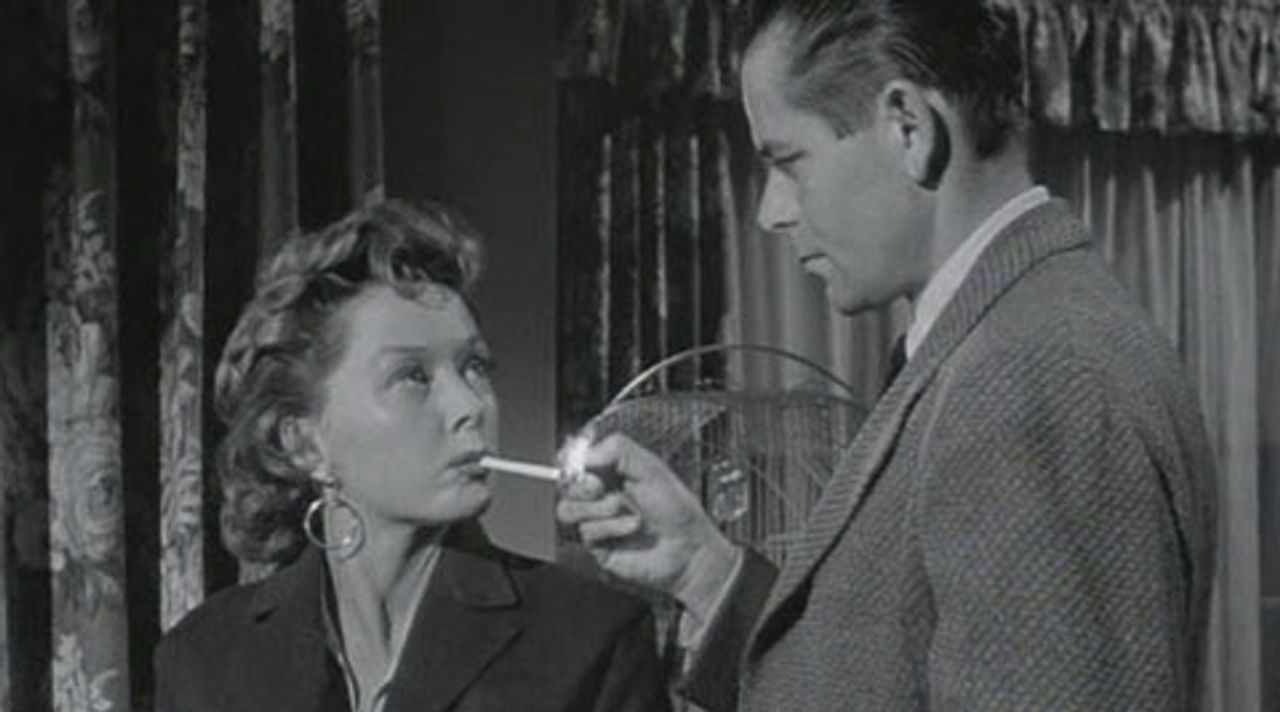 Human Desire
Human DesireIn any event, Fritz Lang, who attended the birth of film noir, directed the 1954 release Human Desire—an American version of Jean Renoir’s La Bête Humaine (1938), based, in turn, on Emile Zola’s novel of the same name. The expressionist visual forms that defined Lang’s earlier works—e.g., Metropolis, M, and You Only Live Once—have been muted over time, but the work still embodies the director’s theme of human desire entrapped and distorted by social forces. Critic Andrew Sarris states the case succinctly: “Lang is determinism.”
Jeff Warren (Glenn Ford), a Korean War veteran just returned to his train conductor job in a small industrial town, becomes entangled in the machinations of a married couple, Carl and Vicki Buckley (Broderick Crawford and Gloria Grahame, respectively). Carl’s mercurial temper and insecurities cause the loss of his job at the railroad yard, while his decision to use his wife’s past association with the yard owner in an unsuccessful attempt to regain his job has tragic consequences and also brings Vicki and Jeff together.
Vicki’s physical charms and aura of danger—Jeff vacillates between a fevered attraction to her and a growing suspicion that she’s exploiting him to get back at Carl for exploiting her—pulls him away from the safe, predictable world represented by a woman who’s very much in love with him, Vera Simmons (Diane DeLaire), daughter of his co-worker and friend Alec Simmons (Edgar Buchanan). The resolution of this conflict is effectively ambiguous.
Lang’s determinism is conveyed through the movie’s visual qualities. The speed and power of the trains is presented as an almost uncontrollable force, especially in the early scenes where the shots, taken from the train’s perspective, hurtle the viewer headlong across bridges and through stations. Low-angle camera shots are often used in the railroad yard to convey the overwhelming power and size of the engines (and the social forces they represent) in relation to the much smaller and weaker human figures. And when the human figures finally attempt to gain some distance and seclusion from the forces controlling their lives, sudden flashes of light often remind them (and the audience) there is no escape.
Broderick Crawford’s Buckley is essentially a decent human being undone by the official 1950s’ American credo that manhood equals possession and power. The always remarkable Gloria Grahame is achingly effective at portraying a woman who wants desperately to gain independence and dignity, but can’t afford either.
Glenn Ford’s respect for his character’s class position and plight is evident in his performance, but he is largely overshadowed by the work of Crawford and Grahame. A weak supporting cast is the movie’s principal flaw.
Fritz Lang later commented critically on the experience of remaking Renoir’s La Bête Humaine, noting that in his film, “the picture was turned on its head. The Renoir film is about the psychopath, a sex killer. This is about a woman who cheats, for no good reason, really. The script was nowhere near the caliber of Clash By Night and very far from the Zola novel about the human beast. Alfred Hayes, the writer, and I wanted to go back to that concept in Zola, but the producer resisted.
“He wanted the woman to be a slut, a beast. … He thought the train going through the tunnel in the Renoir was such a wonderful symbol of sex. I tried to do something different, with the tracks and the boxcars, to give the sense of fate, being hemmed in by massive objects. And we used low-key light in the studio interiors to make the surroundings seem shabby and dreary.”
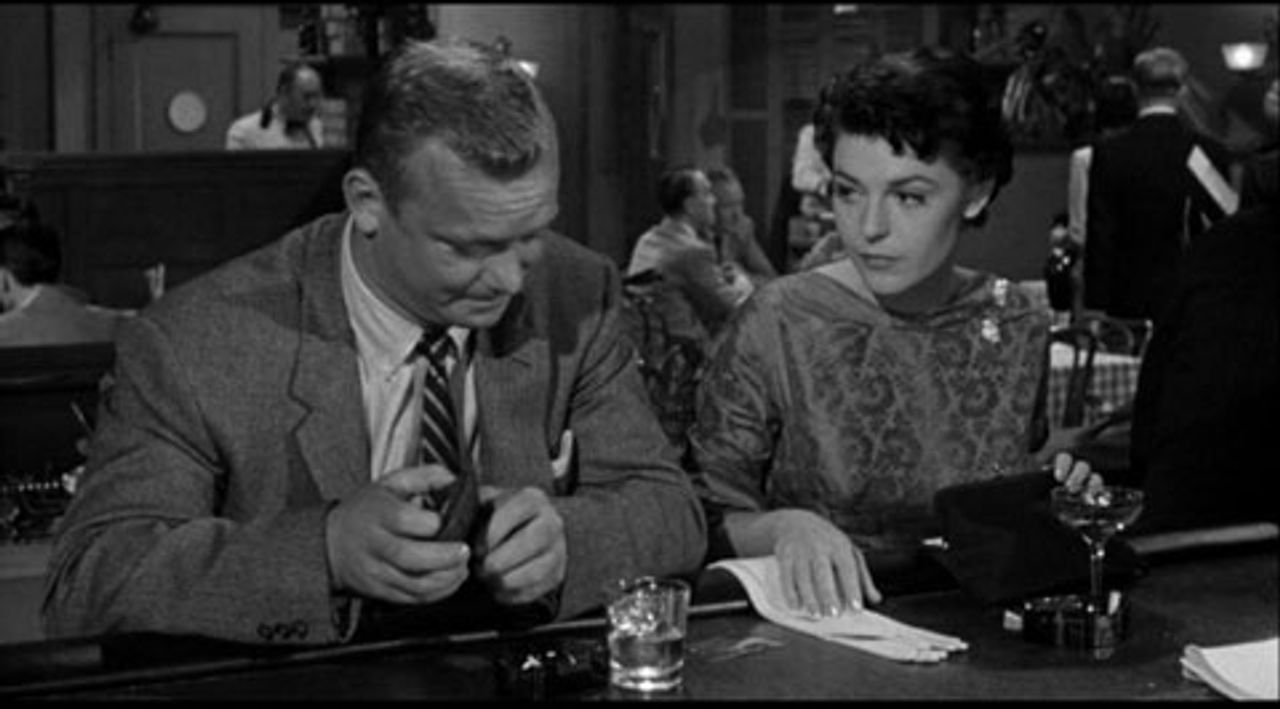 Nightfall
NightfallThe plot of Jacques Tourneur’s Nightfall (1957) is quite similar to that of the director’s 1947 classic, Out of the Past. The central character, World War II veteran and commercial artist James Vanning (Aldo Ray), is hiding from his past in this film too. After he meets and has dinner with a model, Marie Gardner (Anne Bancroft), Vanning is forced into a car by two hoodlums, John (Brian Keith) and Red (Rudy Bond).
A series of flashbacks, intercut with action scenes set in the present, reveal the reason for the pair’s intense interest in Vanning. After stealing $350,000 from a bank, the two thieves wreck their car in Wyoming and encounter Vanning and his friend Dr. Edward Gurston (Frank Albertson), there on a hunting trip. Red kills Dr. Gurston and thinks he has slain Vanning, but mistakenly picks up the doctor’s medical bag, instead of the one holding the money.
In the present, after escaping Red and John, Vanning returns to Marie and together they travel to Wyoming to try and find the money-laden bag.
As in Out of the Past, Tourneur places past action in the open countryside of Wyoming and the present in a large urban area (Los Angeles). Chris Fujiwara in Jacques Tourneur: The Cinema of Nightfall, finds that unlike most film noir, Tourneur’s film sets its scenes of intimacy and warmth in an urban landscape, while the movie’s serious violence takes place against the white barrenness and isolation of the mountainous countryside.
Aldo Ray brings an understated, naturalistic interpretation to James Vanning, fitting for a character who wishes only to find peace from the past he must repress. Brian Keith’s John has a similar need, and, due to his inability to satisfy his need in any legitimate way, attains a level of pathos greater than Ray’s Vanning. Bancroft’s Marie Gardner has the maturity necessary to give Vanning reason to once again trust another human being.
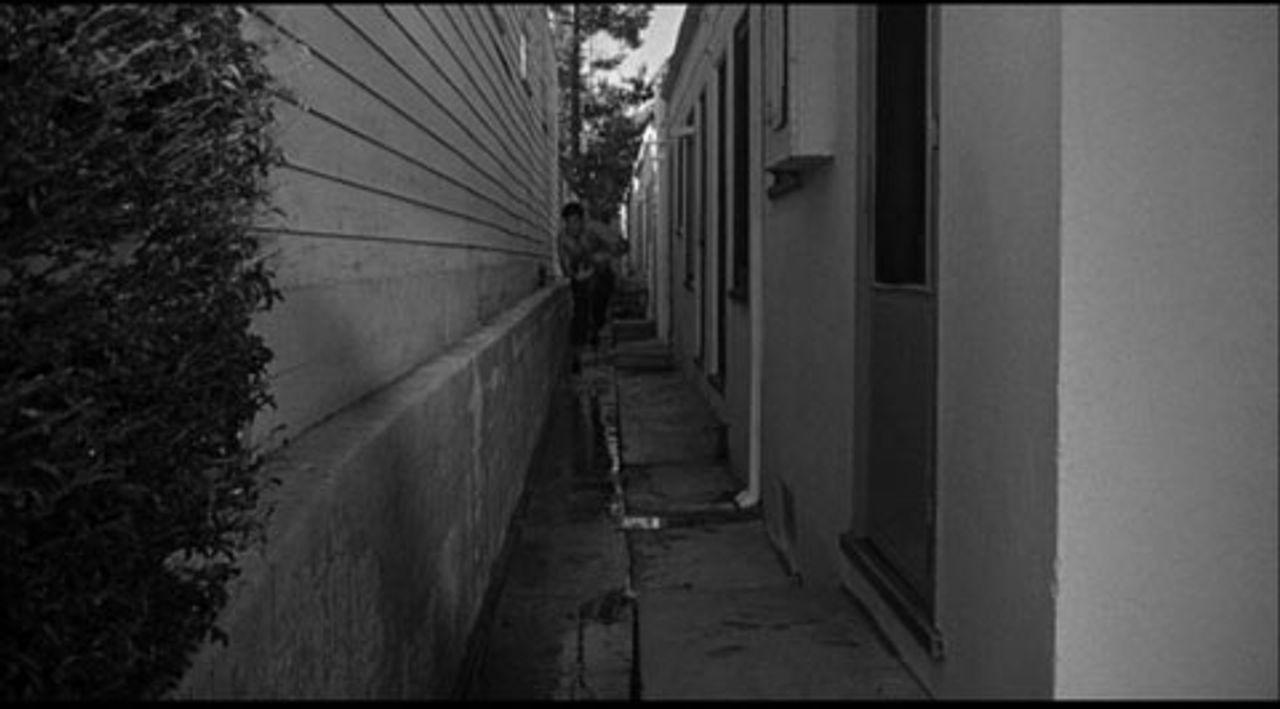 City of Fear
City of FearBy 1959, the threat of nuclear annihilation and the paranoia it engendered were widespread, and the aptly titled City of Fear, directed by Irving Lerner (Murder by Contract, 1958), dramatizes this reality. Vince Ryker (Vince Edwards) is an escaped convict carrying a small steel cylinder that he believes to be full of heroin, but which actually contains cobalt 60 uranium.
The Los Angeles police learn that Ryker is carrying radioactive material, triggering a “ticking time bomb” plot, i.e., we learn that even if the cylinder isn’t opened, the radiation will start affecting the population within 48 hours. As Ryker crosses the city, first to a motel where he meets his lover, June Marlowe (Patricia Blair), then to a shoe store where he once worked, and finally to a diner, the police—directed by Chief Jensen (Lyle Talbot)—attempt to track him down by carrying Geiger counters in their cars.
Afraid of creating a panic, officials do not announce the threat Ryker poses to the public. Consequently, he does not learn of the cylinder’s actual contents and progressively becomes sicker and weaker.
City of Fear’s strongest point may be Lucien Ballard’s cinematography (among a long list of credits, he shot The Wild Bunch, The Caretakers, and the acclaimed documentary, Aruza). Filmed on location in the crisp black-and-white documentary style of the better television police dramas of the era, City of Fear features rear and frontal shots as the desperate, dying Ryker drives across LA, creating a sense of panic and entrapment within the audience. Extreme close-up shots also become more frequent as the movie reaches its climax.
Regrettably, the audience is never truly let in on Ryker’s thoughts and feelings, which might have created greater dramatic tension, as well as empathy for the character’s plight.
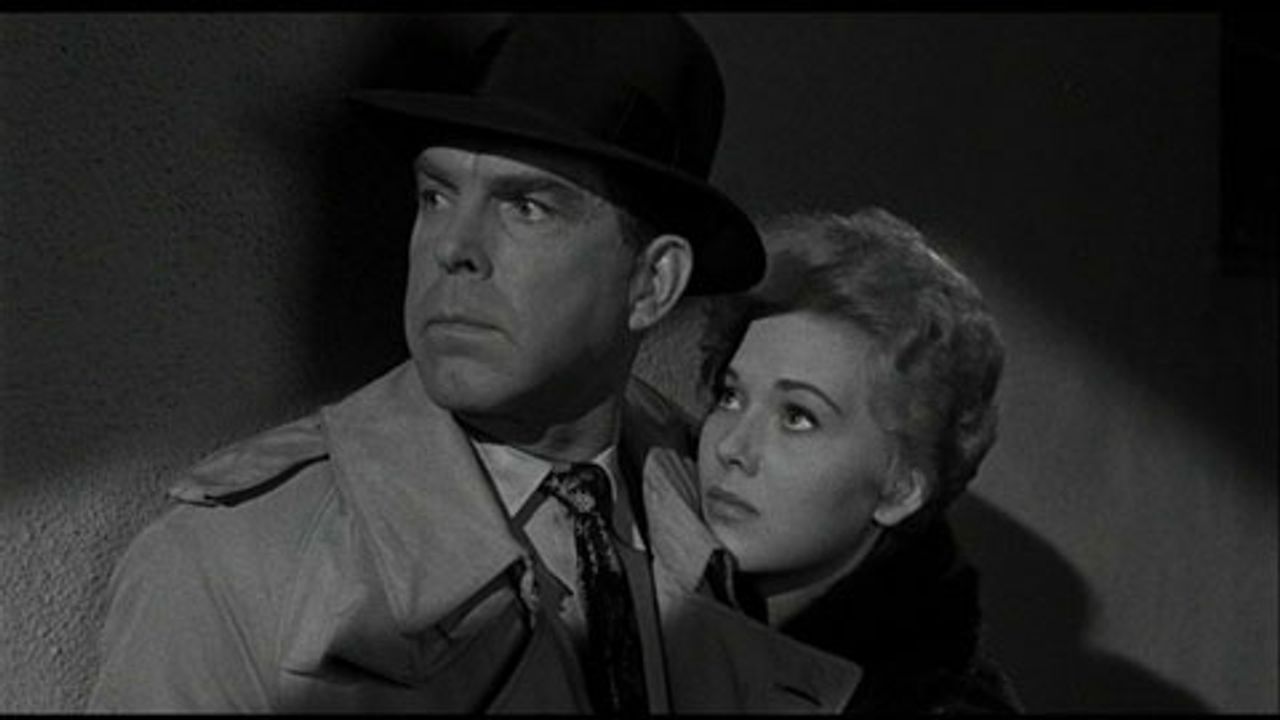 Pushover
PushoverDirector Richard Quine’s Pushover (1954) is, in effect, a reworking of 1944’s Double Indemnity. Fred MacMurray is again the willing object of manipulation by a beautiful blonde, this time Kim Novak, in her first credited role, as Lona McLane. His Paul Sheridan is a cop charged with staking out Mclane in order to catch and arrest her boyfriend, Harry Wheeler (Paul Richards), wanted for a bank heist.
Sheridan is immediately taken in by McLane’s looks and aura of mystery, and as the stake-out continues—Sheridan and his partner, Rick McAllister (Philip Carey), observe her every move from an apartment across the street—he devises various excuses to meet her. After she discovers he is a cop who has always craved money to make up for a poor childhood, she manipulates him into getting rid of her boyfriend and taking the $200,000 he stole.
Pushover shares its theme of voyeurism with other films of this period, such as Hitchcock’s Vertigo, Rear Window, and Psycho, although the Quine film does not share Hitchcock’s critical examination of the repression that underlay this theme. Sheridan’s financial motivation for his actions acknowledges that many Americans holding decent jobs still weren’t making adequate money even in the “golden 50s,” but McLane’s claim that “Money isn’t dirty, just people,” qualifies and weakens this recognition.
The main problem with Pushover is the lack of spark between the Sheridan and McLane characters, and the film’s general lethargy. At no time was Novak the acting equal of Barbara Stanwyck, which accounts in part for this absence; but the greater blame must be placed on an uninspired script that contains little of the emotional charge and wit of the James M. Cain-Billy Wilder-Raymond Chandler penned Double Indemnity.
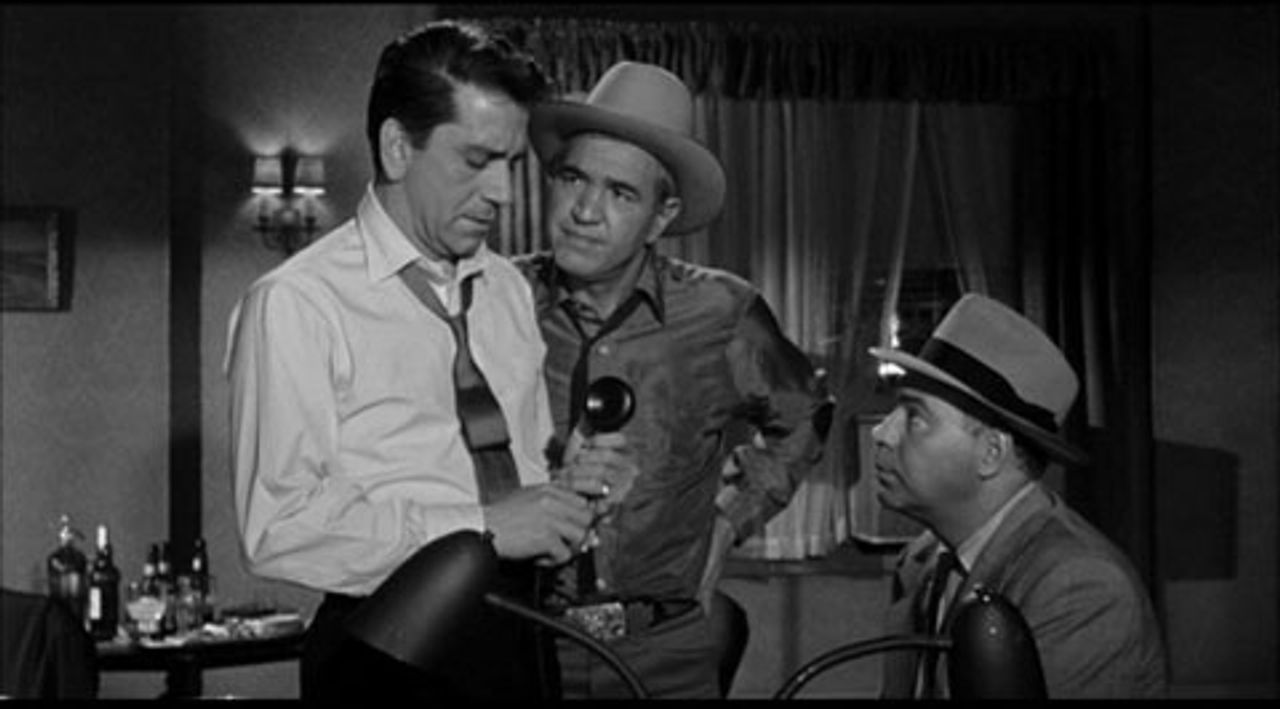 The Brothers Rico
The Brothers RicoDirector Phil Karlson’s The Brothers Rico (1957), a critical take on the business of crime in the postwar boom era, offers a highly credible performance by Richard Conte, but several sub-par performances by other actors.
Former mob accountant Eddie Rico (Conte) is now living the American dream existence—he owns a business (a laundry service), is married to Alice (Dianne Foster), a pretty, stay-at home wife, and hopes to adopt a child.
Eddie learns that his two brothers, still in the crime world, are in trouble, with the mob and the police, and tries to reach them. He initially believes the claims of mob boss “Uncle” Sid Kubik (Larry Gates) that the latter has the Rico brothers’ best interests at heart. He learns otherwise, at great cost.
Conte’s portrayal of Eddie Rico’s dilemma rings true: his character moves gradually and believably from a successful, self-satisfied businessman to a disillusioned figure, and finally to a man who sees the world more realistically and appreciatively.
Several of the actors give sub-par performances. Dianne Foster is too predictable and sometimes wooden as Alice Rico, the typical 1950s wife of a successful businessman; and James Darren overplays the emotional card in his portrayal of younger brother Johnny Rico.
The transfer of the five films to disc is well done, but the accompanying commentaries are not the equal of those found in earlier film noir collections, especially the Warner Bros. products.
